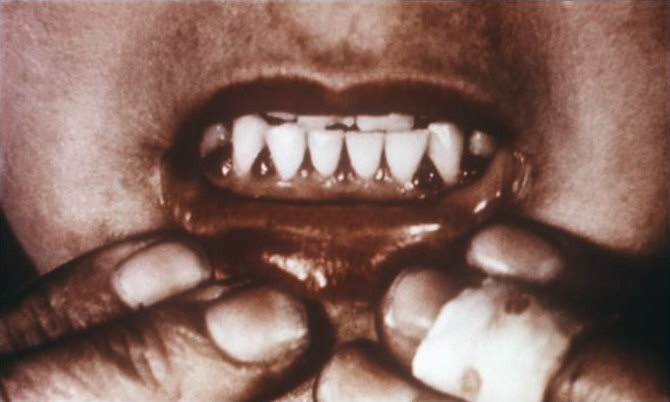Berwick and Winickoff’s 1996 BMJ article, The truth about doctors’ handwriting: a prospective study, suggests that there is no basis for believing that doctors aren’t necessarily that keen on the general public being able to read their notes and prescriptions:
The handwriting of doctors was no less legible than that of non-doctors. Significantly lower legibility than average was associated with being an executive and being male. Overall legibility scores were normally distributed, with median legibility equivalent to a rating between “fair” and “good.”
Many of you nevertheless will have anecdotal evidence that suggests that physicians use written communication as a way of expressing the idea that they are a caste apart.
I just found one such in the work of Aleixo (de) Abreu (1568-1630), whose Tratado de las siete enfermedades (1623) began as an attempt to describe and understand the illnesses (including amoebiasis and yellow fever) he himself suffered whilst on service in Angola and Brazil and ended as the grandaddy of all treatises on tropical medicine.
The chapters on scurvy (which he calls mal de Loanda, Luanda sickness, amusingly eggcorned as mal de Olanda in the days when Dutchmen with inadequate dental plans rued the waves) begin in Spanish with a heartbreaking description of the conditions on the island on which rescued (sic: rescatar) slaves were held awaiting shipment to the Spanish Indies, to the mines of Perú and Potosí, and to Brazilian sugar estates.
This is followed, in the same language, by a discussion of the causes, signs, symptoms and diagnosis of scurvy, along with the news that the author has effected several cures in Lisbon.
Then, just as some poor captain thinks “Aha, I can save my crew!”, along comes Chapter IX, with the encouraging title of “Necessary reminder of why I had to write this cure in Latin”. Reason no 1: This cure is for the use of doctors, not amateurs, however much practical medical experience the latter may have acquired on their travels. It is new and difficult, and beyond the reach of the ignorant men who would seem wise. (And don’t trust those barbers or surgeons either.) (Chunks of Psychopathia Sexualis were also in Latin, for the same reason.)
Reason no 2: Medical science is not as susceptible to discussion in Romance as in Latin. “The essence of things, their differences and qualities, the etymology of expressions and words which we normally use, when said in Romance either cause admiration or terror because of their unfamiliarity, or hilarity and mockery because of their incomprehensibility.”
He closes the chapter with a rant against medical self-help (think: BMA conference bar discussions on patients who use the internet), and then,
having closed the door to ignorant men, who, struggling to read the printed word, on reading such treaties composed in Romance bare their teeth, champ their jaws, writhe their lips, scratch their heads, raise their face and eyes to heaven, and say what they think; … and safe from the barks and bites of some, and intact from the future buffets of others, I begin the cure in the name of the Lord.
But not in the name of the patient: for the cure, as well as being in Latin, is of course a load of crap. Happier those sailors in various accounts who trusted their instincts over their doctors (the Royal Navy didn’t take citrus cures seriously until the early 19th century) and ran ashore begging for oranges.
I’ll post some other time about Portuguese medicine in the 16th century. I’m basically interested in what I think are unrecognised examples of folk medicine being practised successfully where professionals versed in Hippocrates, Aristotle and Galen failed.
On translating Abreu
Afaik there is no translation in existence. In the Complete Dictionary of Scientific Biography article linked to above Francisco Guerra seems to confirm this:
Abreu’s Tratado de las siete enfermedades … was written partly in Spanish and partly in Latin, but because of its corrupt language, archaic terminology, and particularly its extraordinary rarity, no full appraisal of its text has ever been made.
Having read most of it last night without too much difficulty, this seems to me a slightly gloomy assessment.
Certainly there are niggly problems of interpretation. For example, for the passage translated above I could have spent a happy 15 minutes working out whether “arregañando los dientes” is using aregañar ⇠arreganhar, as is common in western (Portuguese and Galician) dialects, or whether it is, confusingingly, ⇠regañar, as in central northern (Asturian and Leonese) speech, in which latter case a satisfactory version would take slightly longer.
But even if we include this, the dubious pleasure of translating mediocre Latin verse, and a couple of extravagant lunches, then 500 subscribers paying 20€ each should be enough to get them each a copy via Lulu or some such of the first English edition of what is a medical classic. So how would one go about organising such a thing? The Point run a Web 2.0 (yawn) facility, but they take a whopping 5%. Er. Um.
Similar posts
Back soon


It was quite normal then (and more recently) in Europe as a whole (including England) for diagnoses to be in the vernacular and cures to be in Latin. I don’t know whether it was a guild thing or just a way of stopping frightened illiterates overdosing on dangerous potions.